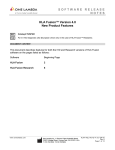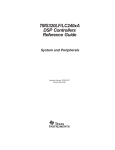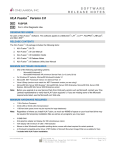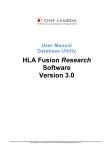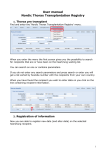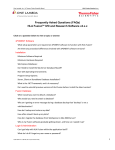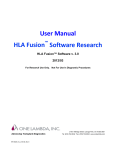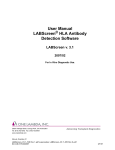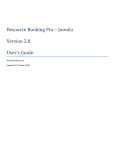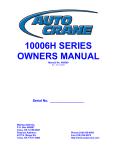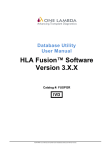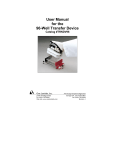Download HLA Fusion Release Notes - Research v3_0
Transcript
SOFTWARE RELEASE NOTES HLA Fusion™ Research Version 3.0 FUSREPGRX For Research Use Only. Not for use in diagnostic procedures. DESIGNATED USERS All users of HLA Fusion™ Research Software. This software applies to ConsenSys, Micro SSP™ for use with EGene, KIR Genotyping, and Quantiplex™ RELEASE CONTENTS The HLA Fusion™ Research 3.0 package includes the following items: 1. HLA Fusion™ Research 3.0 CD 2. HLA Fusion™ Research 3.0 User Manual 3. HLA Fusion™ Research 3.0 Installation Guide 4. HLA Fusion™ Research 3.0 Release Notes 5. HLA Fusion™ Research 3.0 Database Utility User Manual WHAT HAS CHANGED The following changes were made to HLA Fusion Research Software since version 2.0 and its related Service Packs: Enhancements • Users can now select a default Home Page to start with when they log in to HLA Fusion. • The system now provides A1, B2, A1B, and A2B blood type choices on the patient form. • The system has additional tutorial and “Show Me” features in the online help. • Users can now reconfigure any HLA Fusion database to increase the maximum database size. • Users can now merge HLA Fusion & HLA Fusion Research audit log databases. • Users can now include more lab information in custom reports. • Titles on custom reports (such as Molecular Custom) are now limited to 50 characters. • Session ID and Sample ID search in modules such as Manage Data and Reporter now support Chinese characters. • SSP Analysis now ignores the first well (1H) when determining whether to analyze non-amp wells with a positive and negative score • Wildcard searches are now available for the Sample ID filter in the Manage Data module. The system now provides the option to group sessions by test date instead of session date in the navigator. • The system now provides a configuration setting so that the user can choose not to see the warning message about requiring a certain screen resolution, and is not forced to change the screen resolution. • The system now enables switching users without the need to exit the application and then start again with a different login. www.onelambda.com One Lambda, Inc. 21001 Kittridge Street, Canoga Park, CA 91303 USA T: 818.702.0042 F: 818. 702.6904 HFR-REL NOTE-v3.x.x-EN-00, Rev 0 Page 1 of 5 One Lambda, Inc. | Release Notes: HLA Fusion™ Research 3.0 • The system now provides a feature to prevent the overwriting of existing patient information in the Manage Patients module. • The sample date is now displayed during analysis. • Session ID, patient ID, well ID, and test date are now included in the raw data reports from the analyses windows. • The size of SSP gel image in the Custom SSP report is now larger than 700 pixels. • Users can now rotate and zoom in/out of gel images attached to the analysis. • Users can now stay on the current sample after a Save or Confirm without moving to the next sample. • The system now provides separate fields for comments—one for system status messages and one for userentered comments. • When a global cutoff adjustment is made, the system now records it in the comments for only those samples affected by the cutoff. For example, if a global cutoff adjustment is made and only 5 samples out of 96 samples are affected, then the global cutoff status comment is recorded for those five samples only. • The columns in the UMC-Utrecht report labeled A1_1 Result and A1_2 Result now have 4-digit results, excluding the Locus letter (e.g., 03:01). • Users can now create a multi-batch of patient lists by applying the individual patients lists from a Luminex® patient list through the Plate Designer. • Users can now import a batch of Micro SSP sessions, including the ability to browse for files. • Users can now search for a patient by sample ID, local ID, and other patient information. • Users can now search for records by patient ID, and then move, archive or delete that patient’s records as needed. • Users can now generate the Catalog Information Report in the old format. • The system now provides a field for the type of transplant the patient will or has received, with a drop-down list [e.g., SPK (simultaneous pancreas kidney transplantation), KTA (kidney transplant alone), LDKT (living donor kidney transplantation), SPLK (pancreas living-donor kidney), and Other]. There is another drop-down field for patient status (e.g., C0 = in assessment, C1 = active listings, C2 = pending, C3 = transplanted, and C9 = deceased). • The system now provides a Catalog Import Date column in the Catalog Management module. • All Updates Available links for Product Catalogs now display the nomenclature date and revision notes. • If the user selects the Update Previously Downloaded Documents check box next to Get Docs (from the auto update page in Update References), the latest version of documents will be imported, even if older versions were imported previously. • The system now automatically detects if there is a software update/patch and informs users of available updates. The software update “Upgrade” feature is only available to HLA Fusion supervisor level users with Microsoft® Windows® admin rights. • Users can now edit the Patient ID field in the Manage Sample Info to change an existing patient ID or add a patient. • The system now supports transplant history for a given patient. • The system now supports patient CDC, CDC/AHG and VX Cross-matching in the patient management system. • Users can now perform auto and manual as well auto import of P and G groups from the IMGT site. • Users can now input Quantiplex CSV test files. • Patient, Session, Sample information, and Patient Tracking are now integrated as a Web application. • Users can now save homozygous allele code assignments. HFR-REL NOTE-v3.x.x-EN-00, Rev 0 Page 2 of 5 One Lambda, Inc. | Release Notes: HLA Fusion™ Research 3.0 • Users can now more easily select sessions and samples from those sessions when they are starting a new SBT analysis. • The system has a new Specialty Report for exporting KIR data to import into the LIS. • Users can now view the samples in the test list before assigning to the plate design. • Users can now assign and un-assign the samples to the plate. • Users can now assign “Test lists” to the plate. • Users can now search for the samples which already exist in the previously designed plate(s) or in the current plate. • Users can now assign the same sample with same test type more than one time on the same plate; that is, the plate shall support replicates of samples of same test type. • Users can now import a Luminex® patient list on to the plate and assign tests to the samples. Note: A well can hold only one type of test. • Users can now delete/edit all the unassigned plates. • Users can now choose to view and assign already assigned plates. • Users can now assign plates multiple times in the runs. • Users can now delete all runs other than the run currently processing. • For LABScreen custom and express runs on LABXPress, users can now choose the run with or without aliquotion. • Users can now view/print the reagent volumes required for express and custom runs through the run monitor. • The system now validates the reagent loading after the loading is completed. • If the reagent validation is successful, the script now finishes; otherwise, the software displays an error message to reload the vials. • The script now checks for leftover plates in the Luminex®, Centrifuge, and Thermocycler. • The script now requests the software to validate the reagent loading. • The plate is now moved to shaker, shaken for 30 seconds, and moved back to slots. • The 70µl wash buffer is now dispensed to all the wells on the plate having sample. • Users can now choose to select the exe path. • Users can now choose to select the log path. • Users can now select the report type for the plate design. (layout, list, both). • Users can now choose the run with or without Luminex®. • Users can now select the Luminex® software option between IS 2.3 and xPONENT® 3.1. • Users can now select the incubator type used between Bio-Rad® DNA engine and Eppendorf® Master Cycler. • When there is an error in the run, the software now sends email notification if the email notification is active. The configurable accounts are Microsoft® Outlook, yahoo.com, AOL, Hotmail, and gmail.com. • When there is an error in the run, the software now sends a text message to a phone number if the text notification is active. The configurable text accounts shall be cdyne.com, eztexting.com. • The KIR session summary now displays user-assigned values (yes/no) instead of the software-suggested values. HFR-REL NOTE-v3.x.x-EN-00, Rev 0 Page 3 of 5 One Lambda, Inc. | Release Notes: HLA Fusion™ Research 3.0 Bug Fixes • A customer got an error upgrading a database using a SQL login that does not have a sysadmin role. A sysadmin account should be used to properly upgrade the database. • When assigning two test lists which have the same sample ID with the same test assigned on the plate, both samples did not remain on the plate. INSTRUCTIONS Updating Databases from Prior Versions of HLA Fusion Research™ Upgrading a Prior Version of an HLA Fusion Research Database after a New Installation For users of previous versions of HLA Fusion Research: 1. After you have followed the HLA Fusion Research Installation Guide to install version 3.0 of HLA Fusion Research, open the Fusion Research Database Utility by double-clicking the shortcut on your computer desktop. 2. Choose the Upgrade prior versions of HLA Fusion Research database to 3.0 function from the Fusion Research Database Utility. 3. Select the database you want to update, and specify a location in which you want to store a backup copy. 4. Click the ‘Upgrade’ button. 5. Choose the ‘Select Database’ function from the Fusion Research Database Utility. 6. Select the database you upgraded in step 3, and click the ‘Set’ button. Support for New and Old Nomenclature in HLA Fusion™ Research 3.0 Our goal is to provide our customers and users with greater flexibility through the nomenclature change/migration period while keeping the HLA Fusion Research software performance and simplicity in mind. The following only applies to Micro SSP for use with E-Gene products. 1. The HLA Fusion Research 3.0 Database migration/upgrade from prior OLI software/database (e.g. HLA Fusion Research 1.3.1 and earlier versions, HLA Visual, HLA Tools, etc.) will handle the nomenclature update as follows: a. HLA Fusion Research 3.0 software will migrate the data as-is from prior OLI software/databases; meaning the HLA Fusion Research software will not translate old allele names into new allele names during the migration process. b. HLA Fusion Research 3.0 software will upgrade, as-is, the databases created using the HLA Fusion Research 1.2.0, 1.2.1X, 1.3.0 and 1.3.1 versions. HLA Fusion Research software will not translate old allele names into new allele names during the upgrade process. 2. The Sero file that is currently available through the One Lambda download site has been updated to include new alleles. Users are required to download this file first before importing any catalog into the HLA Fusion Research version 3.0 software. Additionally, this file will be used for translation of alleles. The software will not support Sero files created before January 2010. 3. The Patient Import module only accepts alleles in the new format. If a patient import list contains Cw alleles, these will be changed to C. 4. HLA Fusion Research 3.0 software will support the import of catalogs in both old and new allele name formats. The catalog import process in HLA Fusion Research 3.0 software is as follows: a. Catalogs using the new allele naming format are imported as-is. Subsequent analysis/reanalysis will use the new allele name, and results will be stored in the new allele format. Subsequent viewing and reporting modules will display alleles in the new format as well. b. Catalogs using the old allele format are supported as well. In this case, the software gives users the option to either import as-is or translate and import in the new format. If the translation option is selected, HFR-REL NOTE-v3.x.x-EN-00, Rev 0 Page 4 of 5 One Lambda, Inc. | Release Notes: HLA Fusion™ Research 3.0 the old allele names are translated into new allele names during the import, and any old alleles which do not have corresponding new alleles are dropped and not imported. 5. Data Management: a. We have added a Translate option to the Data Management screen where selected sessions in the old allele format can be translated into the new allele format. Changes made on this screen are updated in the database. Please note that only results will be translated. In addition, please note the following: b. Other assignments, Serology, and NMDP code stay as-is. c. Old alleles will be left as-is if they do not have a matching new allele. 6. Analysis: a. We have also added a Translation option to the analysis windows for Micro SSP to display old alleles in the new format if this option is selected. The translation is temporary, and it will only translate results. Please refer to item 5 above for more details. b. For combined and supplemental analysis, the analysis results will be displayed in the new format even if one of the samples has been analyzed using old allele format. 7. Reporting and viewing of results in HLA Fusion Research3.0: a. The viewing and reporting of results will be based on what is in the database. This means results in the old allele format will show old alleles and results in new allele format. REVISION HISTORY Revision Date HFR-REL NOTE-v3.x.x-EN-00, Rev 0 Revision Description Page 5 of 5





